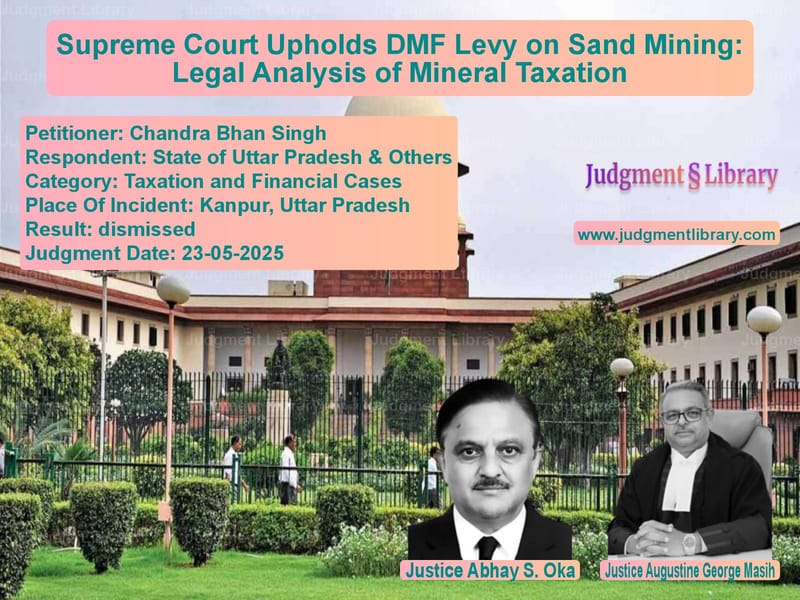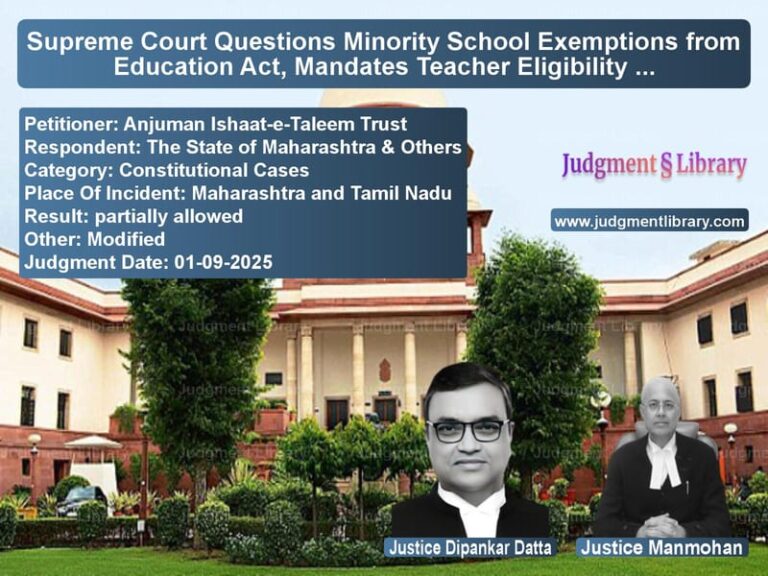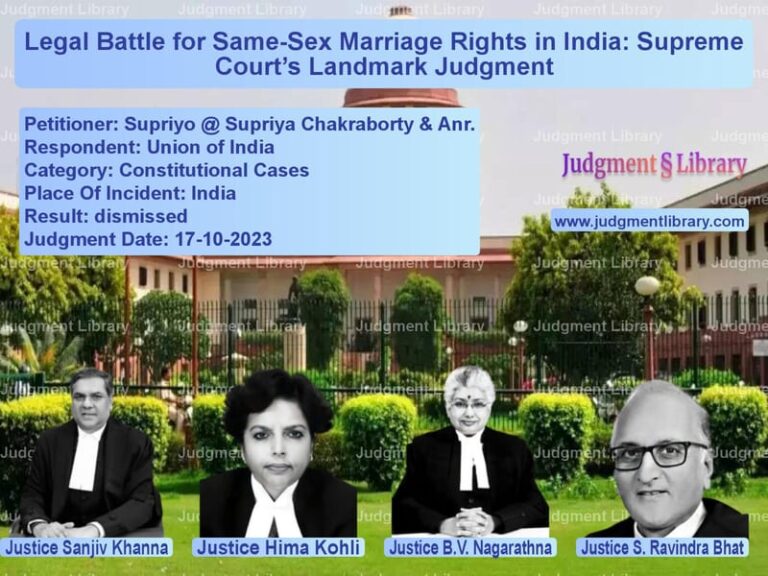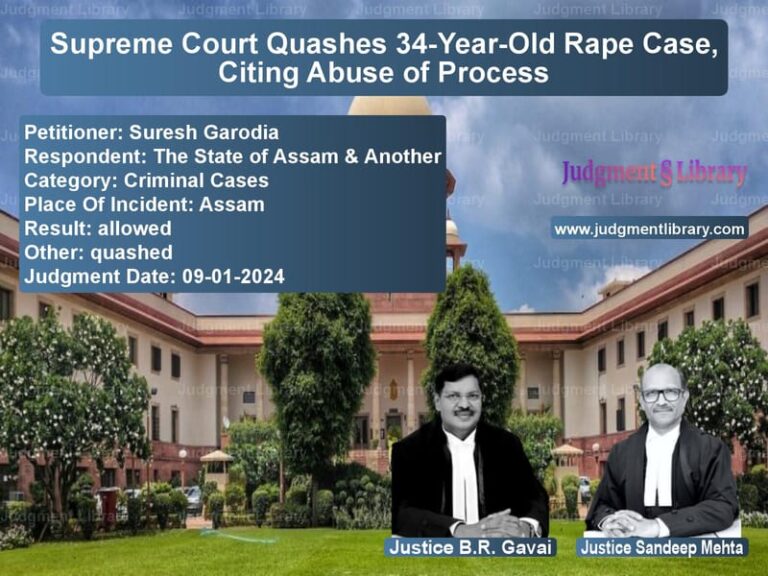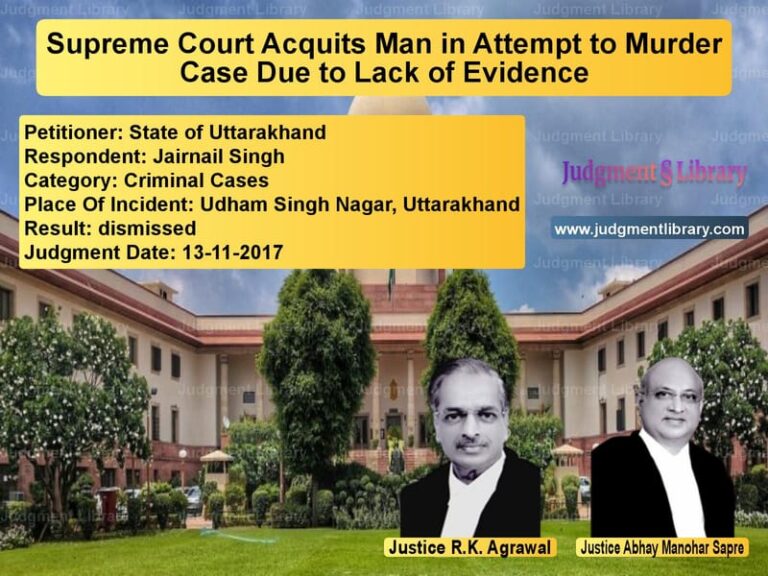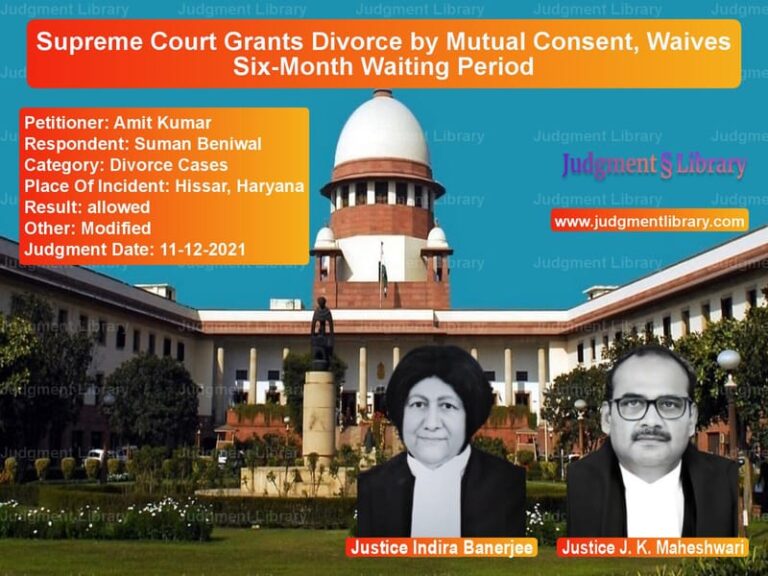Supreme Court Upholds DMF Levy on Sand Mining: Legal Analysis of Mineral Taxation
In a significant ruling that clarifies the taxation powers of state governments in mineral mining operations, the Supreme Court of India recently delivered a judgment that has far-reaching implications for the mining industry, particularly for minor minerals like sand. The case involved Chandra Bhan Singh, a successful bidder for sand mining operations in Uttar Pradesh, who challenged the state government’s demand for depositing 10% of his total bid amount with the District Mineral Foundation Trust. The legal battle, which traveled from the Allahabad High Court to the Supreme Court, centered around the interpretation of various provisions of the Mines and Minerals (Development and Regulation) Act, 1957, and the rules framed thereunder. The Court’s decision not only upholds the state’s power to levy such charges but also provides crucial clarity on the distinction between major and minor minerals under Indian mining law.
The Case Background
Chandra Bhan Singh emerged as the successful bidder for mining minor minerals, specifically sand, in Uttar Pradesh. Following the tender allocation and in accordance with the state’s policy decision dated April 22, 2017, the appellant was required to deposit a substantial amount of ₹54,12,960, representing 10% of the total deposited title amount of ₹5,41,29,600, to the District Mineral Foundation Trust in Kanpur. This was in addition to a 2% stamp fee on the same amount, as specified in the demand notice dated October 25, 2017. The appellant had already deposited the amount payable for the approved mining quantity at the rate of ₹630 per cubic meter of sand, totaling ₹5,41,29,600, as per his bid and the mining permit dated October 16, 2017.
The appellant challenged this demand notice before the Allahabad High Court, arguing that the claimed amount contradicted the provisions of Section 9B of the Mines and Minerals (Development and Regulation) Act, 1957. This section requires deposits to be made according to the royalty fixed in the Second Schedule of the Act. When the High Court dismissed his challenge through its judgment dated November 15, 2017, the appellant approached the Supreme Court, leading to the present appeal.
The Appellant’s Arguments
The learned Senior Counsel for the appellant raised several crucial legal points challenging the validity of the demand notice and the underlying policy. “The learned Senior Counsel for the Appellant has asserted that the Policy decision dated 22.04.2017 itself is not sustainable as the due process for issuance thereof as provided for in Rule 68 of the Uttar Pradesh Minor Minerals (Concession) Rules, 1963 (hereinafter, ‘1963 Rules’) have not been adhered to.” He argued that while Rule 68 enabled relaxation of the rules, the impugned policy actually claimed an amount much higher than what was fixed in the First Schedule appended to the 1963 Rules.
The counsel extensively referred to Section 9B of the 1957 Act, contending that “the DMF, as has been formulated and conceptualized, provides for charging and deposit of amount in addition to the royalty equivalent to such percentage of the royalty paid in terms of the Second Schedule of the 1957 Act which would not be exceeding one-third of such royalty, as may be prescribed by the Central Government.” He asserted that when the rate had been fixed by the state at 10% of the royalty, the payable amount should be limited to that extent, and demanding a percentage of the entire bid amount was unsustainable.
Referring to Section 15 of the 1957 Act, which confers powers on state governments to make rules for minor minerals, the counsel argued that “Section 9B would be applicable for all intents and purposes and not merely for constitution, composition and functioning of the DMF, which includes the amount in addition to the royalty required to be deposited with it.” He emphasized that the state cannot claim an amount contrary to the rate fixed by the central act.
The counsel also referenced Rule 54, which deals with the deposit of royalty for the total quantity of mineral allowed to be extracted under the permit, and Rule 21 of the 1963 Rules, which mandates royalty payment at rates specified in the First Schedule. Based on these provisions, he asserted that the High Court erred in concluding that Rules 21 and 54 were not applicable to the case.
The State’s Defense
The learned Additional Solicitor General for the respondent-state vigorously defended the impugned judgment, presenting a compelling counter-argument. “On the other hand, learned Additional Solicitor General for the Respondent-State has defended the Impugned Judgment by asserting that the provisions of Sections 9 and 9B of the 1957 Act would not be applicable to the case in hand in light of Section 14 of the said Act, which provides that Sections 5 to 13 would not apply to minor minerals.” She argued that the appellant’s reliance on Section 9B was fundamentally misplaced.
The ASG emphasized the state’s rule-making powers under Section 15 of the 1957 Act, stating that “the State Government, by Notification in the Official Gazette, stands empowered to make Rules for regulating the grant of quarry leases, mining leases or other mineral concessions in respect of minor minerals and for purposes connected therewith.” She clarified that under sub-section (4) of Section 15, the government could make rules for regulating the provisions of the act, including how the DMF Trust would work for the interest and benefit of affected persons and areas as provided in sub-section (2) of Section 9B.
Regarding the specific power to fix payments to the DMF Trust, the ASG referred to “Clause (c) of sub-Section (4) of Section 15 which empowers the State Government to fix and regulate the amount of payment to be made to the DMF Trust by the mining concession holders of minor minerals as provided in Section 15A which, in turn, empowers the State to prescribe the payment to be made of the amount to the DMF Trust.” On this basis, she asserted that the rate of 10% of the amount fixed by the state for deposit with the DMF Trust could not be faulted.
The ASG also made a significant procedural argument regarding the policy challenge. “As regards the challenge to the Policy decision dated 22.04.2017, the learned ASG has asserted that the said Policy had not been challenged before the High Court and thus, the same cannot be challenged before this Court now.” She further noted that the appellant had participated and succeeded in the e-tender floated under this very policy and therefore could not challenge the policy after availing its benefits.
The Supreme Court’s Analysis
The Supreme Court bench comprising Justice Abhay S. Oka and Justice Augustine George Masih delivered a comprehensive judgment analyzing all aspects of the case. The Court first addressed the challenge to the policy decision dated April 22, 2017, noting that the original records had been produced before the Court as directed.
After examining the records, the Court observed: “On considering the records as produced, the process which has been followed while considering, evaluating and deliberating the factors which weighed while assigning reasons for coming to the conclusion have been perused by us. The same finds reflected, projected and mentioned in the letter dated 22.04.2017 after due consideration at different levels upto the highest competent authority leading to a reasoned decision at the end of the State for exercising its powers under Rule 68 of the 1963 Rules which is found to be fulfilling the requirement of the Rule.”
The Court also noted an important contextual factor: “It would not be out of way to mention here that an Order dated 18.04.2017 was passed by the Lucknow Bench of the High Court in a Public Interest Litigation which had permitted and required the exercise of powers under Rule 68 of 1963 Rules by the State. This was because of the peculiar situation which was being faced by the State for the total ban on mining activity having been imposed leading to the stopping and delaying of construction and other development works, both in the Government sector as well as the private sector.”
The Court then addressed the core legal issue regarding the applicability of Section 9B. In a crucial finding, the Court stated: “This contention of the Appellant is unsustainable firstly on the ground that Section 9B of the 1957 Act would not be applicable in the light of Section 14 of the said Act, which reads as follows: ’14. Sections 5 to 13 not to apply to minor minerals – The provisions of sections 5 to 13 inclusive shall not apply to quarry leases, mining leases or other mineral concessions in respect of minor minerals.'”
The Court elaborated: “A perusal of Section 14 would make it clear that Sections 5 to 13 of the 1957 Act would not be applicable to the present case as the mineral which is sought to be mined is a minor mineral i.e., sand. The plea therefore of the Appellant based on Section 9B(5) is misplaced and thus, unacceptable.”
The judgment provided a detailed analysis of Section 15(4) of the 1957 Act, noting: “The applicability and the effect of Section 9B (2) and (3) is limited to the extent as has been mentioned in Clause (a) and (b) of sub-Section (4) of Section 15 of the 1957 Act.” The Court explained that clauses (a) and (b) operate within their specific domains and do not deal with the amount to be charged or deposited in the DMF, which is specifically addressed in clause (c) referring to Section 15A.
The Court reproduced Section 15A for clarity: “’15A. Power of State Government to collect funds for District Mineral Foundation in case of minor minerals. – The State Government may prescribe the payment by all holders of concessions related to minor minerals of amounts to the District Mineral Foundation of the district in which the mining operations are caried on.'” Based on this, the Court concluded: “The empowerment being there under the Statute conferred on the State to determine the amount and the fixation thereof for minor minerals cannot be faulted with. The impugned Demand Notice thus being in consonance with the Statutory provisions cannot be said to be illegal or unsustainable.”
The Court also addressed Rule 10(2) of the District Mineral Foundation Trust Rules, 2017, which states: “‘In case of minor minerals- The holder of every mineral concession/permit shall in addition to the royalty, pay to the Trust of the district in which the mining operations are carried on, an amount which is equivalent to 10% of royalty or as may be prescribed by the State Government from time to time.'” The Court interpreted this provision to mean that “apart from the royalty, an amount of 10% of the royalty is payable to the DMF Trust of the district in absence of any prescribed amount by the State Government. However, in case an amount is prescribed by the State Government then the said rate or amount would prevail and be payable at the end of the holder of the mineral concession or permit.”
Finally, the Court dismissed the appellant’s reliance on Rules 21 and 54 of the 1963 Rules, citing Rule 23(3), which states: “‘On the declaration of the area or areas under sub-rule (1) the provisions of chapters II, III and VI of these rules shall not apply to the area of areas in respect of which the declaration has been issued. Such area or areas may be leased out according to the procedure described in this Chapter.'” Since Rule 21 falls in Chapter III and Rule 54 in Chapter VI, and the e-tender process was being followed, these rules were not operative.
Implications and Conclusion
The Supreme Court’s judgment has significant implications for the mining sector, particularly for minor minerals like sand. By clearly distinguishing between the regulatory regimes for major and minor minerals, the Court has affirmed the states’ authority to determine the financial contributions to District Mineral Foundations for minor minerals. This clarification is crucial as it empowers state governments to tailor their mining policies according to local requirements while ensuring that funds are available for the development of mining-affected areas.
The judgment also reinforces the principle that parties who voluntarily participate in a tender process and derive benefits therefrom cannot subsequently challenge the terms and conditions of that process. This approach promotes certainty and stability in commercial and governmental transactions.
Furthermore, the Court’s detailed analysis of the statutory framework provides valuable guidance for future cases involving the interpretation of the Mines and Minerals (Development and Regulation) Act, 1957, and the rules framed thereunder. The judgment strikes a balance between the interests of miners, who seek predictability in their financial obligations, and the state’s responsibility to ensure that mining activities contribute to the welfare of affected communities through the District Mineral Foundation mechanism.
In dismissing the appeals and upholding the demand notice, the Supreme Court has not only resolved the immediate dispute between Chandra Bhan Singh and the State of Uttar Pradesh but has also provided much-needed clarity on the complex interplay between central and state powers in regulating minor minerals in India.
Petitioner Name: Chandra Bhan Singh.Respondent Name: State of Uttar Pradesh & Others.Judgment By: Justice Abhay S. Oka, Justice Augustine George Masih.Place Of Incident: Kanpur, Uttar Pradesh.Judgment Date: 23-05-2025.Result: dismissed.
Don’t miss out on the full details! Download the complete judgment in PDF format below and gain valuable insights instantly!
Download Judgment: chandra-bhan-singh-vs-state-of-uttar-prade-supreme-court-of-india-judgment-dated-23-05-2025.pdf
Directly Download Judgment: Directly download this Judgment
See all petitions in Tax Evasion Cases
See all petitions in Income Tax Disputes
See all petitions in GST Law
See all petitions in Customs and Excise
See all petitions in Tax Refund Disputes
See all petitions in Judgment by Abhay S. Oka
See all petitions in Judgment by Augustine George Masih
See all petitions in dismissed
See all petitions in supreme court of India judgments May 2025
See all petitions in 2025 judgments
See all posts in Taxation and Financial Cases Category
See all allowed petitions in Taxation and Financial Cases Category
See all Dismissed petitions in Taxation and Financial Cases Category
See all partially allowed petitions in Taxation and Financial Cases Category

